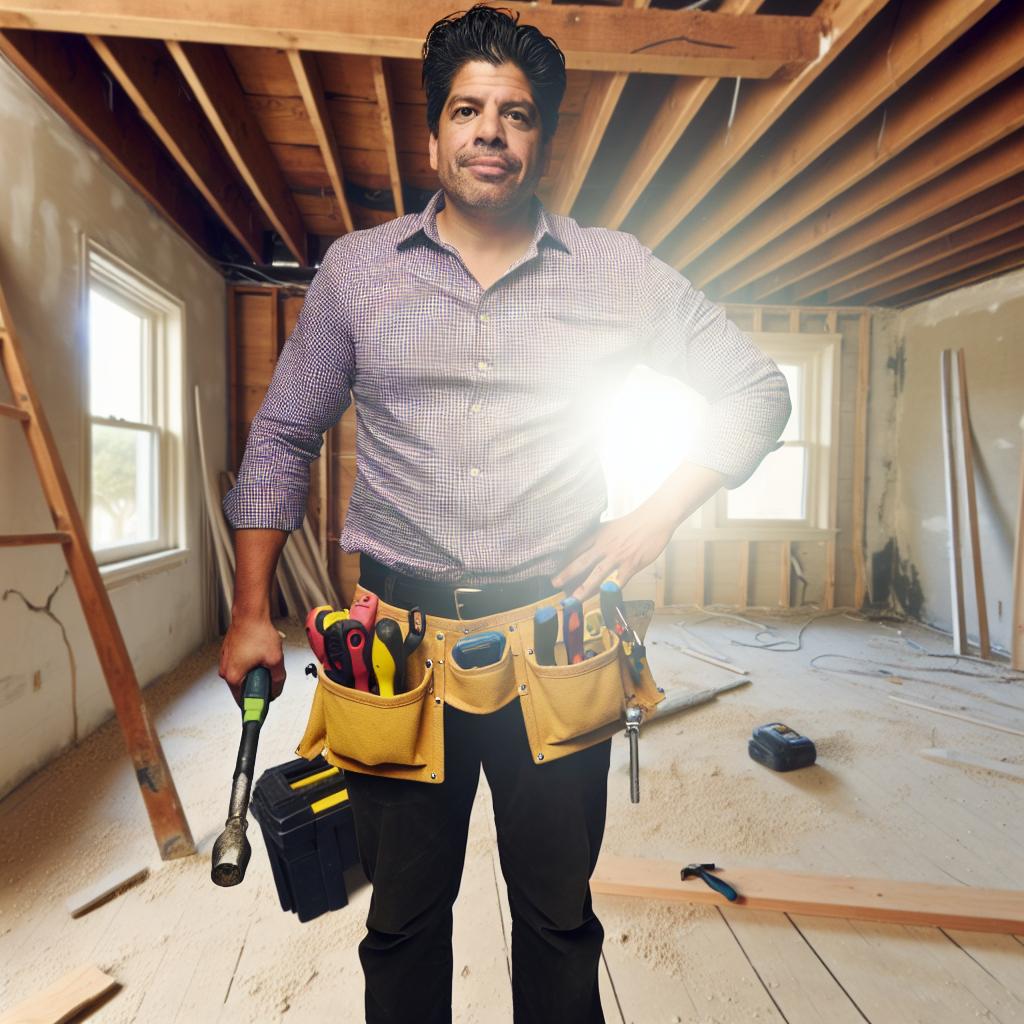Introduction to DIY Renovation and the Importance of Safety
DIY renovation can be an exciting endeavor for real estate enthusiasts.
However, safety should always come first.
Many homeowners take on renovation projects to add value to their properties.
They often underestimate the potential risks involved.
Taking the right precautions is crucial for a successful and safe renovation.
To begin with, understanding safety protocols can prevent accidents.
Understanding Common Risks
Every DIY project has its set of risks to consider.
From power tools to hazardous materials, awareness is key.
For instance, falling from heights during a roofing project can be dangerous.
Additionally, improper handling of tools can cause injuries.
Moreover, exposure to chemicals can pose health risks.
Thus, knowing these risks allows you to take preventive measures.
Preparation is Essential
Planning your project is the first step to ensuring safety.
Begin by assessing the areas to be renovated carefully.
Gather all necessary materials and tools before starting.
Transform Your Real Estate Decisions
Unlock personalized real estate insights crafted just for you. Get actionable advice designed to amplify your success.
Get StartedMoreover, create a timeline to keep your project organized.
This way, you can avoid rushing through tasks, which often leads to accidents.
Utilizing Proper Safety Gear
Wearing appropriate safety gear is vital during DIY renovations.
Always use safety goggles to protect your eyes from debris.
A dust mask can prevent inhalation of harmful particles.
Furthermore, gloves will protect your hands from cuts and chemicals.
It’s wise to wear sturdy footwear to avoid slipping and injuries.
Learning and Following Safety Guidelines
Educate yourself on safety guidelines related to your project.
Consult manuals that come with tools for proper use instructions.
For larger projects, consider watching tutorial videos online.
Additionally, it may be beneficial to attend workshops or classes.
Following these guidelines empowers you to work confidently.
Knowing When to Call for Help
Understand your skill limits when undertaking renovations.
If a task seems beyond your capabilities, seek professional help.
Showcase Your Real Estate Business
Publish your company profile on our blog for just $200. Gain instant exposure and connect with a dedicated audience of real estate professionals and enthusiasts.
Publish Your ProfileFor example, electrical and plumbing work often requires skilled tradespeople.
Don’t hesitate to ask for assistance when necessary.
Ultimately, prioritizing safety will lead to a successful DIY renovation.
Essential Safety Gear for DIY Renovators
Introduction to Safety Gear
DIY renovations can be exciting but also dangerous.
Wearing the right safety gear helps prevent accidents.
Notably, certain tools and equipment are essential for every project.
Eye Protection
Protecting your eyes is crucial when renovating.
Safety glasses or goggles shield against debris and chemicals.
Choose a pair that fits snugly and meets safety standards.
Additionally, consider face shields for extra protection when using power tools.
Hearing Protection
Many renovations involve loud noises from tools.
Earplugs or earmuffs can significantly reduce noise exposure.
Ideally, select noise-canceling options to enhance comfort.
Respiratory Protection
Working with dust and fumes can be harmful to your lungs.
A good respirator protects against inhaling hazardous substances.
Opt for one rated for the specific materials you’ll be handling.
Hand Protection
Your hands are vulnerable during renovations.
Durable gloves safeguard against cuts and abrasions.
Different tasks may require different types of gloves.
For example, use cut-resistant gloves when handling sharp materials.
Foot Protection
Protecting your feet is essential in any renovation project.
Steel-toe boots provide safety against falling objects.
Moreover, slip-resistant soles help prevent accidental falls.
Body Protection
Coveralls or durable long sleeves keep you safe from injuries.
Choosing materials that are resistant to chemicals can offer additional protection.
Furthermore, don’t forget about knee pads for those long hours on the ground.
Important Tips for Safety Gear
Always check your gear for damage before starting a project.
Ensure your equipment fits correctly for maximum protection.
Regularly replace worn-out or outdated safety gear.
Finally, educate yourself on proper usage for each safety item.
Showcase Your Real Estate Business
Publish your company profile on our blog for just $200. Gain instant exposure and connect with a dedicated audience of real estate professionals and enthusiasts.
Publish Your ProfileUnderstanding Basic Tools and Their Safe Usage
Overview of Common Tools
Understanding your tools is essential for any renovation project.
Every tool serves a specific purpose in DIY tasks.
Common tools include hammers, screwdrivers, and power drills.
Each tool has unique safety features and usage guidelines.
Safety Precautions
Always wear the appropriate safety gear while working.
This includes safety glasses and gloves to protect your eyes and hands.
Ensure your work area is well-lit and spacious.
A clutter-free space reduces the risk of accidents.
Using Hand Tools Safely
When using hand tools, maintain a firm grip on the handle.
This helps prevent slips and injuries.
Always cut away from your body to avoid accidents.
Regularly inspect your tools for signs of wear or damage.
Using Power Tools Responsibly
Power tools require additional caution due to their speed and force.
Always read the user manual before operating a new tool.
Check that all safety guards are in place before use.
Never remove safety features for convenience.
Proper Storage of Tools
After use, store tools in a designated, secure location.
This keeps them out of reach of children and pets.
Keep tools organized to save time finding the right ones.
Consider using a toolbox or pegboard for easy access.
Explore Further: Renovation Cost Estimation for Kitchen Remodeling Projects
Evaluating the Workspace: Best Practices for a Safe Environment
Assessing Hazards
Start by identifying potential hazards in your workspace.
Look for sharp objects, exposed wires, and unstable structures.
Remove any obstructions that could cause tripping hazards.
Consider using a checklist to ensure thorough evaluation.
Proper Lighting
Ensure your workspace is well-lit to avoid accidents.
Use bright, even lighting to reduce shadows and improve visibility.
Replace any burnt-out bulbs promptly to maintain safety.
Consider adding task lighting for detailed work areas.
Ventilation and Air Quality
Good ventilation is essential for a healthy workspace.
Showcase Your Real Estate Business
Publish your company profile on our blog for just $200. Gain instant exposure and connect with a dedicated audience of real estate professionals and enthusiasts.
Publish Your ProfileOpen windows or use fans to circulate air effectively.
Consider using air purifiers, especially in enclosed spaces.
Regularly check for and remove sources of poor air quality.
Organizing Tools and Materials
Keep tools and materials organized and stored safely.
Use labeled containers to easily identify items.
Return tools to their designated spaces after each use.
Ensure frequently used items are easily accessible to reduce clutter.
Personal Protective Equipment
Always wear appropriate personal protective equipment.
This includes gloves, goggles, and hard hats during renovations.
Make sure your equipment fits properly for maximum protection.
Replace any damaged gear immediately to ensure safety.
Establishing Clear Exit Routes
Ensure that exit routes in your workspace are clearly marked.
Keep pathways unobstructed for safe and quick exits.
Conduct regular drills to familiarize everyone with exit procedures.
Review and update your exit plan as needed throughout the project.
Learn More: Key Benefits of Using Sustainable Materials in Home Remodeling Projects
Identifying and Addressing Potential Hazards Before Starting
Assess Your Environment
Start by examining the renovation site carefully.
Look for signs of structural damage or decay.
Identify any loose wires or exposed electrical fixtures.
Be aware of hazardous materials, such as asbestos or lead.
Consider potential slip or trip hazards around the area.
Gather Necessary Safety Equipment
Ensure you have appropriate personal protective equipment (PPE).
Hard hats, gloves, and safety goggles are essential.
Respirators may be necessary if you’re handling hazardous materials.
Wear steel-toed boots to protect your feet during heavy lifting.
Establish Clear Safety Protocols
Develop a safety plan for all individuals on-site.
Review emergency exit routes before starting work.
Ensure everyone understands the first aid procedures.
Assign a safety officer to oversee compliance and procedures.
Communicate Effectively
Hold a meeting to discuss safety concerns with the team.
Showcase Your Real Estate Business
Publish your company profile on our blog for just $200. Gain instant exposure and connect with a dedicated audience of real estate professionals and enthusiasts.
Publish Your ProfileEncourage everyone to speak up about potential hazards.
Post warning signs in visible areas to remind workers.
Regularly update the team on any changes to protocols.
Stay Informed About Local Regulations
Research and understand local building codes and regulations.
Check for permits required for your renovation work.
Keep up to date with safety standards set by local authorities.
Consult with professionals if you’re unsure about regulations.
Explore Further: Renovation Cost Estimation for Energy-Efficient Homes
Safety Protocols for Electrical and Plumbing Work
Understanding Risks
Electrical and plumbing work can pose significant risks.
Identify potential hazards before starting any project.
Awareness of risks helps prevent injuries and accidents.
Preparation and Planning
Begin by gathering all necessary tools and materials.
Ensure your workspace is organized and clutter-free.
This preparation fosters a safer working environment.
Protective Equipment
Wearing appropriate protective gear is essential.
Use safety goggles to protect your eyes from debris.
Wear gloves to guard against cuts and chemical exposure.
Consider using hard hats in overhead workspaces.
Electrical Safety Practices
Always shut off power before working on electrical systems.
Test circuits with a multimeter to ensure they are dead.
Use tools with insulated handles to reduce shock risk.
Additionally, do not overload circuits to prevent fires.
Plumbing Safety Practices
Turn off water supplies before starting plumbing work.
Use proper tools to avoid injury when handling pipes.
Wear kneepads when working in uncomfortable positions.
Be cautious of chemical drain cleaners and follow instructions.
Emergency Preparedness
Always have a first-aid kit accessible during projects.
Know emergency contact numbers for quick response.
Keep fire extinguishers on hand when working with electrical systems.
Regularly review safety protocols to ensure readiness.
Showcase Your Real Estate Business
Publish your company profile on our blog for just $200. Gain instant exposure and connect with a dedicated audience of real estate professionals and enthusiasts.
Publish Your ProfileGain More Insights: Renovation Cost Estimation for Garage Conversions

Proper Lifting Techniques and Ergonomics to Prevent Injuries
Understanding Proper Lifting Techniques
Proper lifting techniques are essential for injury prevention.
They help maintain your physical well-being during renovations.
Begin by assessing the load before attempting to lift it.
Ensure you can comfortably manage the weight without strain.
Approach the load with a stable stance.
Position your feet shoulder-width apart to enhance balance.
Use your legs for lifting instead of your back.
Bend at your knees, not your waist, to pick up the item.
Keep the load close to your body when lifting.
This minimizes stress on your back and helps maintain posture.
Using Ergonomics to Your Advantage
Ergonomics is vital in home renovation tasks.
It involves designing your workspace to reduce strain.
Adjust your working height using tables or platforms.
This helps avoid bending or twisting unnecessarily.
Use tools that are ergonomically designed for comfort.
These tools can significantly reduce the risk of repetitive strain injuries.
When working on ladders or scaffolding, follow safety guidelines.
Ensure your equipment is stable and secure before use.
Implementing Safe Lifting Practice
Incorporate safe lifting practices into your routine.
Always ask for help when lifting heavy or awkward items.
This reduces risk and promotes teamwork on renovations.
Take breaks to avoid fatigue during long lifting sessions.
Listen to your body and stop if you feel any discomfort.
Using a dolly or hand truck can ease the burden of heavy loads.
These tools help transport materials more safely across distances.
Maintaining a Safe Work Environment
A clutter-free workspace enhances safety during lifts.
Remove any obstacles or hazards before starting your task.
Ensure adequate lighting in all work areas to improve visibility.
Keep a first aid kit nearby for immediate access in emergencies.
Showcase Your Real Estate Business
Publish your company profile on our blog for just $200. Gain instant exposure and connect with a dedicated audience of real estate professionals and enthusiasts.
Publish Your ProfileRegularly inspect your tools and equipment for any issues.
Report or repair any damaged items to avoid accidents.
Staying informed about lifting techniques promotes a safer renovation experience.
Emergency Preparedness
First Aid Kits
Every DIY enthusiast should maintain a well-stocked first aid kit.
Include bandages, antiseptic wipes, and gauze in your kit.
Add pain relievers and allergy medications as needed.
Consider including specialized items for your specific projects.
Check your kit regularly to ensure all supplies are up to date.
Familiarize yourself with the contents for quick access during emergencies.
Handling Accidents
Accidents can happen despite all precautions taken.
Stay calm when an injury occurs to assess the situation clearly.
Apply basic first aid immediately for minor injuries.
If necessary, don’t hesitate to call for professional medical help.
Communicate clearly about the nature of the injury when help arrives.
Always have emergency contact numbers readily available.
Emergency Contact Information
Prepare a list of emergency contact numbers in advance.
Include local emergency services and poison control contacts.
Store this list in an easily accessible location on your worksite.
Additionally, make sure all team members know its location.
Regularly update the list to prevent outdated information.
Safety Training
Consider safety training for you and your team.
This training can cover basic first aid and emergency response techniques.
Invite local organizations to offer workshops and classes.
Encouraging a culture of safety improves everyone’s preparedness.
Review safety protocols regularly to keep everyone informed.
Stay informed about the latest safety practices and techniques.
Promoting a Safety-First Mindset in DIY Projects
Understanding the Importance of Safety
Safety should always be your top priority in DIY projects.
Proper planning helps prevent accidents before they happen.
Furthermore, a safety-first mindset fosters a healthy working environment.
Preparing Your Workspace
A clean workspace minimizes hazards during your projects.
Showcase Your Real Estate Business
Publish your company profile on our blog for just $200. Gain instant exposure and connect with a dedicated audience of real estate professionals and enthusiasts.
Publish Your ProfileEnsure that your area is well-lit and organized.
This preparation allows for efficient movement and reduces risks.
Selecting the Right Tools
Using the right tools improves safety and efficiency.
Always select tools appropriate for the specific project.
Inspect your tools regularly to ensure they are in good condition.
Utilizing Personal Protective Equipment
Personal protective equipment is essential for minimizing injuries.
Always wear gloves, goggles, and masks when necessary.
This equipment protects you from harmful materials and hazards.
Educating Yourself and Others
Knowledge significantly enhances safety during DIY projects.
Consider attending workshops to learn proper techniques.
Also, share your knowledge with anyone assisting you.
Being Prepared for Emergencies
Having an emergency plan is crucial for any DIY project.
Keep a first-aid kit accessible in your workspace.
Ensure everyone knows emergency procedures before starting.
Continuous Evaluation and Improvement
Regularly assess your safety practices during projects.
Seek feedback and make adjustments when necessary.
This ongoing evaluation cultivates a culture of safety awareness.




